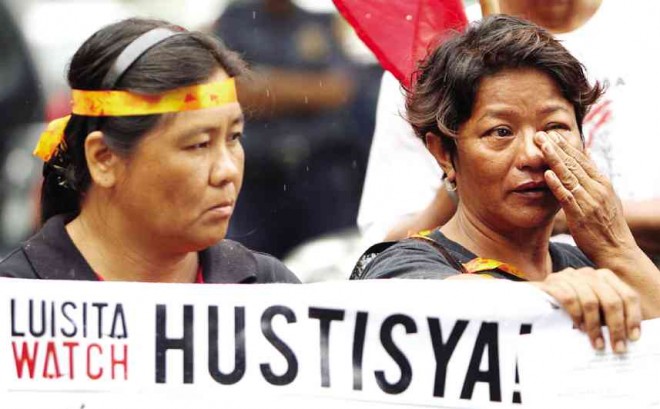
VIOLETA Basilio (right) weeps during the protest action for the victims of the 2004 Hacienda Luisita Massacre where several sugar workers, including her only son Jhaivie, died during the bloody dispersal. LYN RILLON
CITY OF SAN FERNANDO— Relatives of seven striking workers killed in the 2004 Hacienda Luisita Massacre asked the Office of the Ombudsman on Monday to reopen criminal and administrative cases filed against President Aquino, who was implicated in that atrocity when he was Tarlac province representative.
Complainants Gabriel Sanchez, Violeta Basilio, Luisita Versola and Florida Sibayan also asked the Ombudsman to reopen similar cases filed against Gen. Gregorio Pio Catapang, Armed Forces of the Philippines chief of staff.
The other public respondents were then Labor Secretary Patricia Sto. Tomas, Labor Undersecretary Manuel Imson and sheriff Francis Reyes. The private respondents in the complaint were Mr. Aquino’s uncles and Hacienda Luisita owners Pedro and Jose Cojuangco, Ricardo and Jose Manuel Lopa and sugar mill executive Ernesto Topacio.
This new petition exposes the role supposedly taken by Mr. Aquino in the violent dispersal of strikers on Nov. 16, 2004, in the sugar estate owned by his family.
The victims’ families filed the omnibus motion in the Office of the Ombudsman in Quezon City, assisted by their lawyers from Sentro para sa Tunay na Repormang Agraryo, Public Interest Law Center and Pro-Labor Legal Assistance Center.
The motion said the public respondents, including the President, then a representative of Tarlac, “committed grave abuse of authority, grave misconduct and conduct unbecoming of a public office.”
In a joint order on July 11, 2005, the Ombudsman cleared then Representative Aquino of charges for multiple murder, multiple frustrated murder, multiple attempted murder, murder, physical injuries, theft and malicious mischief that arose from the shooting and killing of Jaime Pastidio, Jhaivie Basilio, Adriano Caballero, Jessie Valdez, Jesus Laza, June David and Juancho Sanchez.
They were killed when workers fought back after Sto. Tomas ordered the military and the police to reclaim a gate of Central Azucarera de Tarlac (CAT) where CAT Labor Union (Catlu) and United Luisita Workers’ Union (Ulwu) set up barricades.
The Ombudsman division tasked to investigate military personnel absolved Catapang, then an official of the military’s Northern Luzon Command based in Tarlac, of similar charges on Dec. 10, 2010.
The complainants said the Ombudsman dismissed the cases despite the fact that seven men were killed and 121 workers, including children and the elderly, were hurt.
“Can there be no crime even if seven persons have been found dead while others have suffered serious and less serious physical injuries? Who then should be held liable for the infamous Hacienda Luisita Massacre?” a part of the motion read.
The complainants said they were not furnished nor did they receive copies of the two orders clearing Mr. Aquino and the other respondents, “hence, as to them, the reglementary period to file this motion did not run.”
The petitioners sought copies of the order and the report of the National Bureau of Investigation, which they said was the basis of the recommendation of the Ombudsman.
They said the NBI did not take their statements, which, they added, violated their right to due process.
Sought for comment on Monday, Catapang said he was not the ground commander when soldiers and policemen regained the entrance to CAT.
“I have been cleared by the Ombudsman. That was a long time ago. Why is it being resurrected?” Catapang told the Inquirer.
The complainants also said the Ombudsman “failed to consider” that Sto. Tomas’ order assuming jurisdiction of strike covered only that of Catlu and not the strike being waged by Ulwu.
“After the massacre, [Mr. Aquino] defended the action of the military and the police. In his speech at the House of Representatives on Nov. 17, 2004, the day after the massacre,
[Mr. Aquino], then deputy speaker, justified the dispersal of the protesters. He said that elements of the [AFP] and the Philippine National Police who dispersed the workers were ‘subjected to sniper fire coming from an adjacent barangay,’” the complainants said.
“He also said there was strong evidence that the clash was triggered by gunfire coming from the ranks of the strikers and that when the police tried to break the barricade using an armored personnel carrier (APC), they were fired upon by strikers,” the motion said.
“[Mr. Aquino] cited there were at least eight bullet marks on the APC. However, to date, no evidence to establish his claim was ever presented. He also discouraged his militant colleagues in Congress of conducting fact-finding missions at the Hacienda, which he said could further ‘inflame the situation,’” it said.